
Understanding Environment and Ecosystems: Key Concepts for NCERT, CBSE, and RBSE Curriculum
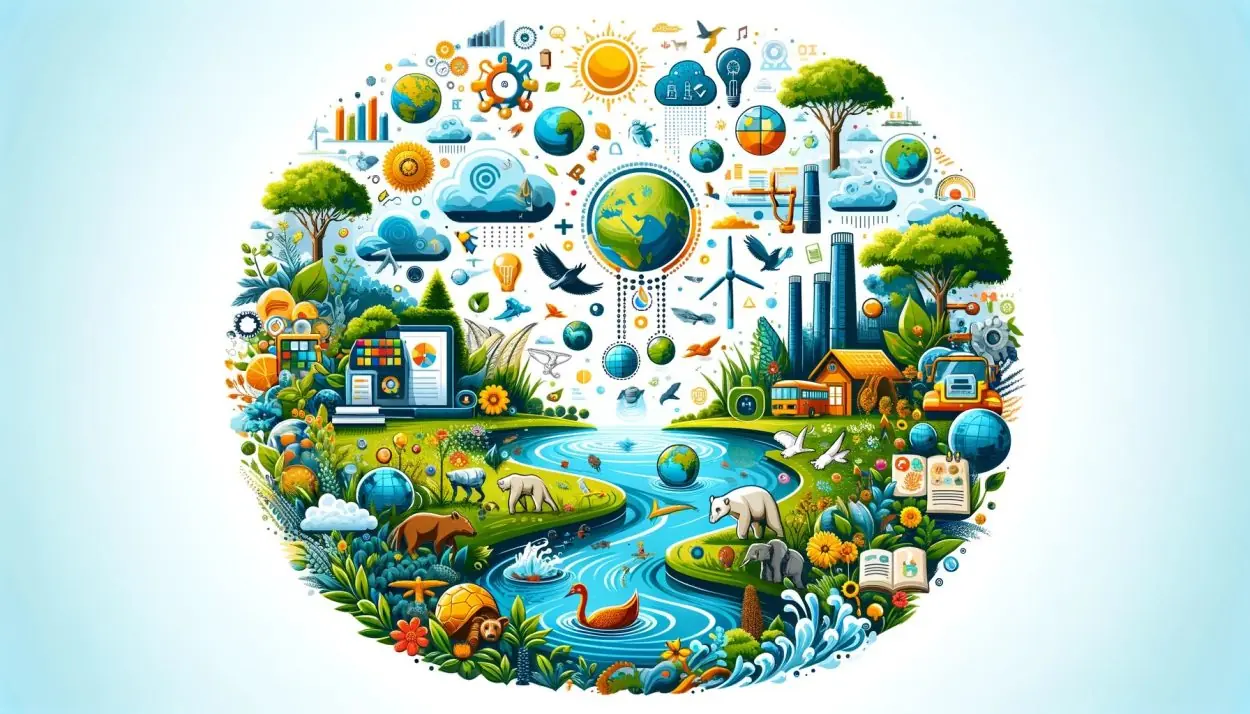
Chapter: Our Environment and Ecosystem
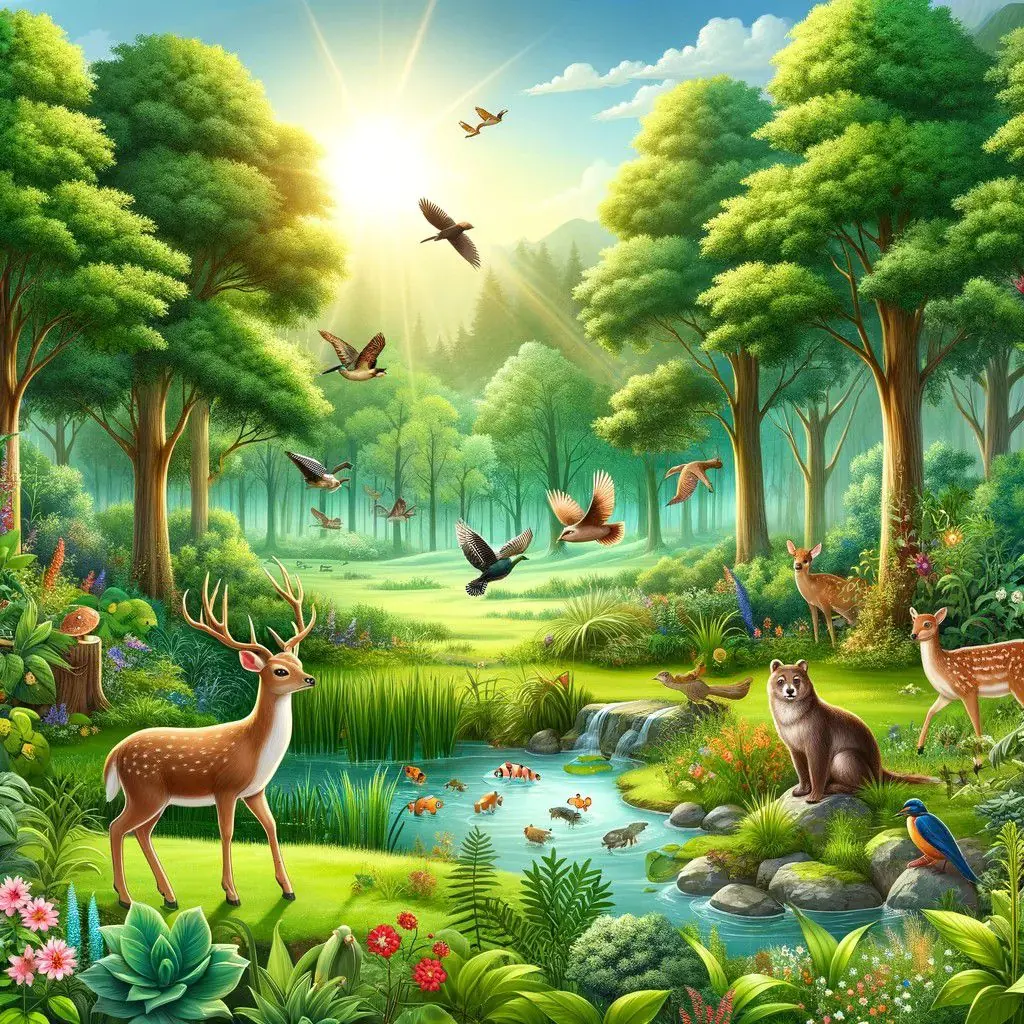
I. Introduction
Definition and Importance of the Environment and Ecosystems
The environment and ecosystems are fundamental concepts in understanding the natural world and our place within it.
The Environment
- Definition: The environment refers to all external conditions and influences affecting the life and development of organisms. It encompasses both living (biotic) and non-living (abiotic) components.
- Biotic Components: These include all living beings, from microscopic bacteria to large mammals, including humans.
- Abiotic Components: These are non-living factors like water, air, soil, sunlight, and temperature.
The environment is not just a backdrop for life but a dynamic system that interacts constantly with organisms.
The Ecosystem
- Definition: An ecosystem is a community of living organisms in conjunction with the non-living components of their environment, interacting as a system.
- Components: This includes producers like plants, consumers like animals, and decomposers like fungi and bacteria.
- Diverse Ecosystems: Ecosystems vary enormously in size and complexity, from a small pond to a large forest or an entire ocean.
The importance of understanding both the environment and ecosystems lies in their role in sustaining life. Ecosystems provide essential services such as clean water, air, and fertile soil, which are the foundations of our survival.
Overview of the Interdependence Between Living Organisms and Their Physical Surroundings
The relationship between living organisms and their environment is a key aspect of ecology, the branch of biology that studies these interactions.
Interdependence
- Mutual Influence: Organisms affect and are affected by their environment. For example, plants depend on sunlight, water, and nutrients to grow, and they, in turn, provide oxygen and food for other organisms.
- Adaptation: Over time, organisms evolve specific traits to better survive in their environments. This is evident in the diverse forms of life found in different climates and conditions.
Ecosystem Dynamics
- Food Chains and Webs: These demonstrate how energy and nutrients flow through an ecosystem, showing the interdependence of different species.
- Ecological Niches: Each species has a unique role or ‘niche’ in its ecosystem, contributing to the overall health and balance of the environment.
Human Impact
- Influence on Ecosystems: Humans have a profound impact on the environment and ecosystems. While we rely on them for resources and sustenance, our activities often disrupt these natural systems.
- Responsibility: Understanding this interdependence is crucial for developing sustainable practices to protect and preserve the environment.
In conclusion, the introduction to “Our Environment and Ecosystem” lays the foundation for understanding the complex and intricate relationships that define our natural world. It underscores the importance of both the environment and ecosystems in maintaining the delicate balance required for life to thrive and highlights the critical role humans play in this dynamic.
II. Understanding the Environment
A. Components of the Environment
1. Abiotic Factors
Abiotic factors are the non-living parts of the environment that have a significant impact on living organisms.
- Air: Air is essential for the survival of many organisms. It provides oxygen for respiration, carbon dioxide for photosynthesis, and is a medium for the dispersal of pollen and seeds. The atmosphere also protects living beings from harmful solar radiation and maintains the Earth’s temperature.
- Water: Water is a fundamental necessity for all known forms of life. It’s involved in various biological processes like photosynthesis, digestion, and excretion. Water bodies are habitats for aquatic life and play a crucial role in weather patterns and climate.
- Soil: Soil is a complex mixture of organic matter, minerals, gases, liquids, and countless organisms. It supports plant life, which forms the base of food chains. Soil quality and composition affect agriculture, plant growth, and the distribution of plant species.
2. Biotic Factors
Biotic factors refer to all the living components in an ecosystem.
- Plants: Plants are primary producers, converting solar energy into chemical energy via photosynthesis. They are fundamental to most food chains and contribute to the oxygen and water cycles.
- Animals: Animals play various roles in ecosystems. Herbivores serve as primary consumers, while carnivores and omnivores act as secondary and tertiary consumers. Animals also act as pollinators, seed dispersers, and are crucial for nutrient cycling.
- Microorganisms: These include bacteria, fungi, and algae. Microorganisms play essential roles in decomposing organic matter, recycling nutrients, fixing nitrogen, and in various biochemical cycles.
B. Human Interaction with the Environment
1. Positive Impacts
Humans have the capability to positively affect the environment through conscious decisions and actions.
- Conservation Efforts: Efforts like reforestation, wildlife conservation, and protection of natural habitats help preserve biodiversity.
- Sustainable Practices: Sustainable agriculture, renewable energy use, and recycling reduce environmental degradation.
- Environmental Restoration: Actions like cleaning up polluted areas and reintroducing native species help restore ecological balance.
2. Negative Impacts
Unfortunately, human activities often have detrimental effects on the environment.
- Pollution: Air, water, and soil pollution from industrial activities, vehicular emissions, and improper waste disposal harm ecosystems.
- Habitat Destruction: Deforestation, urbanization, and agriculture lead to the loss of habitats, which is a major threat to biodiversity.
- Climate Change: Emissions of greenhouse gases from human activities are causing global climate change, affecting weather patterns, sea levels, and various ecosystems.
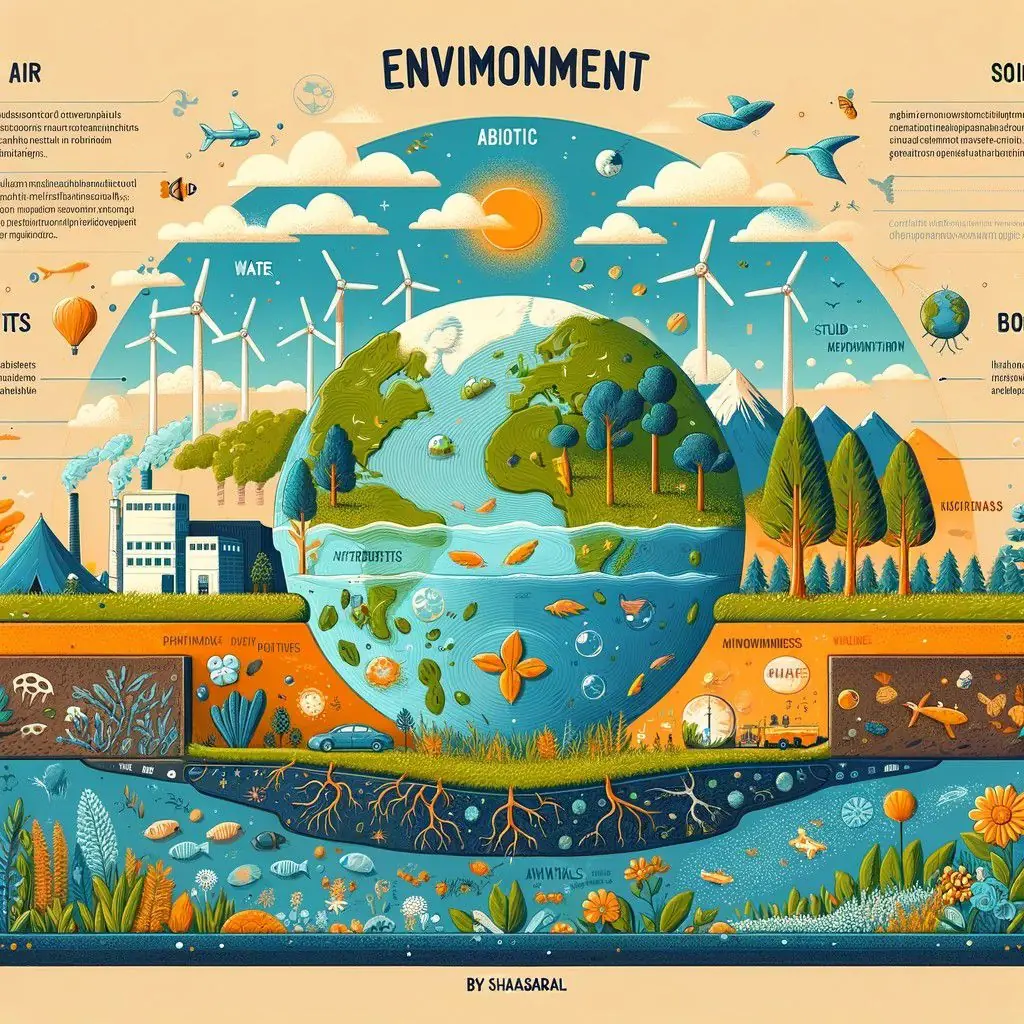
In conclusion, understanding the environment involves recognizing the intricate balance between its biotic and abiotic components and acknowledging the profound impact human actions have on it. This knowledge is crucial for guiding our interactions with the natural world towards sustainability and conservation.
III. The Concept of Ecosystems
A. Definition and Characteristics
An ecosystem is a fundamental concept in ecology and environmental science. It refers to a community of living organisms in conjunction with the non-living components of their environment, interacting as a system. The characteristics of an ecosystem include:
- Interdependence: All members of an ecosystem, both living and non-living, are interconnected and depend on each other for survival.
- Dynamic Nature: Ecosystems are dynamic entities. They are subject to periodic disturbances and are in constant flux, adapting and evolving over time.
- Energy Flow: Energy flows through the ecosystem in a linear sequence from primary producers to various consumers.
- Nutrient Cycling: Ecosystems recycle nutrients, passing them from the physical environment to living organisms and back.
B. Types of Ecosystems
Ecosystems vary greatly in size and complexity and are typically classified into two main types:
1. Terrestrial Ecosystems
These are ecosystems found on land and include:
- Forests: Dense areas of trees and underbrush. They are classified further based on climate and geographical location (tropical rainforests, temperate forests, boreal forests).
- Deserts: Arid regions with sparse vegetation. They can be hot (like the Sahara) or cold (like the Gobi).
- Grasslands: Dominated by grasses and have few trees. Examples include savannas and prairies.
- Mountain Ecosystems: Characterized by a wide range of temperatures and climates, and home to a variety of flora and fauna adapted to mountainous conditions.
2. Aquatic Ecosystems
Aquatic ecosystems are those in water and are divided into:
- Freshwater Ecosystems: Include rivers, lakes, streams, and ponds. These ecosystems have a low salt content.
- Marine Ecosystems: Oceans and seas, which cover about 71% of the Earth’s surface. They have a high salt content and include coral reefs, oceanic trenches, and coastal ecosystems.
C. Components of an Ecosystem
An ecosystem consists of all the living and non-living things in a particular area, interacting with each other. Its main components include:
1. Producers
- Role: Producers, or autotrophs, are organisms that produce their own food using sunlight (through photosynthesis) or chemical energy.
- Examples: Plants, algae, and certain bacteria.
2. Consumers
- Role: Consumers, or heterotrophs, obtain energy by consuming other organisms.
- Types:
- Primary Consumers (Herbivores): Eat producers (e.g., deer, rabbits).
- Secondary Consumers (Carnivores or Omnivores): Feed on primary consumers (e.g., wolves, bears).
- Tertiary Consumers: Top predators that eat secondary consumers (e.g., eagles, sharks).
3. Decomposers
- Role: Decomposers break down dead or decaying organisms, returning essential nutrients to the soil or water.
- Examples: Bacteria, fungi, and some insects.
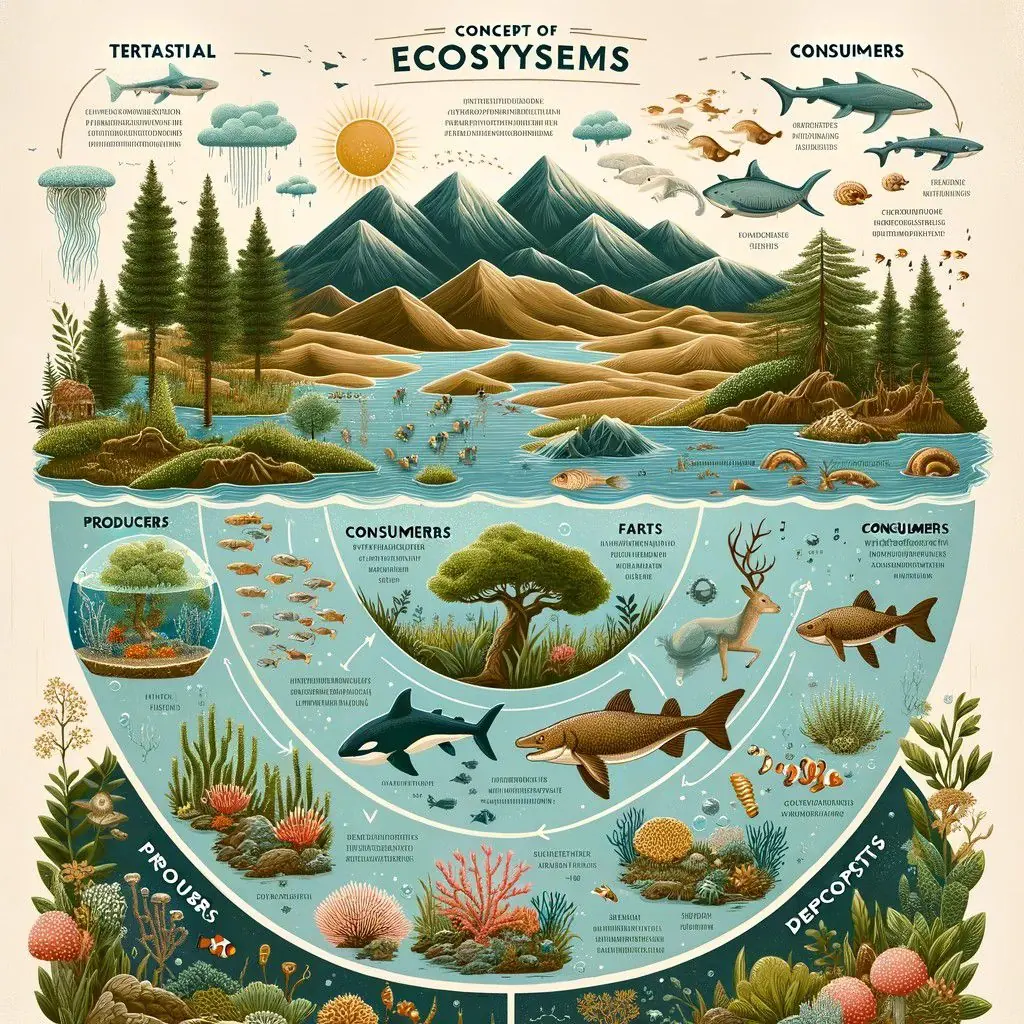
Understanding the concept of ecosystems is essential for appreciating the complexity and balance of the natural world. It highlights the intricate relationships and dependencies among various living organisms and their physical environment.
IV. Ecological Interactions and Relationships
Ecological interactions and relationships are fundamental aspects of biology that describe how organisms interact within their ecosystems. These interactions are crucial for the maintenance of ecological balance and biodiversity. Let’s break down each of these topics:
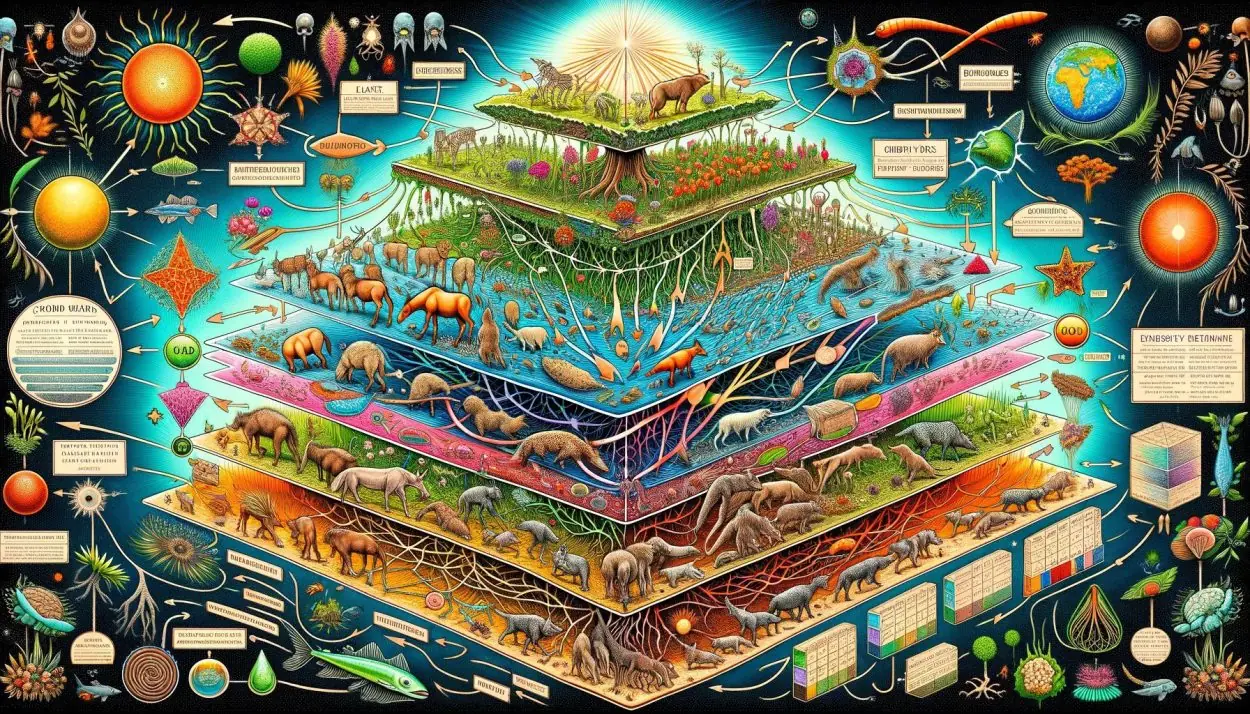
A. Food Chains
A food chain is a linear sequence of organisms where nutrients and energy pass from one organism to another. It typically starts with a producer, such as a plant that can make its own food through photosynthesis. The next level is composed of consumers, which are organisms that eat other organisms. There are primary consumers (herbivores) that eat producers, followed by secondary and tertiary consumers (carnivores or omnivores) that eat the primary consumers or other carnivores. Finally, decomposers or detritivores break down dead organisms, returning nutrients to the soil.
B. Food Webs
A food web is a more complex and realistic representation of how species feed on each other in an ecosystem. Unlike the linear food chain, a food web shows the network of interconnected food chains and highlights the multiple feeding relationships among different organisms. This demonstrates how an ecosystem is interconnected and how the impact on one species can affect many others.
C. Energy Flow in Ecosystems
Energy flow in ecosystems refers to the transfer of energy from one part of the ecosystem to another. Energy enters the ecosystem through the process of photosynthesis by producers. This energy is then passed on to consumers when they eat the producers. As energy moves up the food chain or web, it diminishes, with only a small fraction of the energy transferred from one trophic level to the next. This decrease is due to energy being used by organisms for metabolic processes and also being lost as heat.
D. Ecological Pyramids
Ecological pyramids are graphical representations that show the relationship between different trophic levels in an ecosystem. There are three types of ecological pyramids: pyramids of numbers, biomass, and energy. A pyramid of numbers shows the number of organisms at each trophic level. A pyramid of biomass displays the total biomass at each trophic level. The pyramid of energy illustrates the amount of energy present at each trophic level and is always an upright pyramid, indicating the loss of energy at each transfer.
These concepts are crucial in understanding how ecosystems function and maintain balance. They also help us comprehend the impact of human activities on natural ecosystems and the importance of conservation efforts.
V. Biogeochemical Cycles
Biogeochemical cycles are natural processes that recycle nutrients in various chemical forms from the environment to organisms and then back to the environment. These cycles are vital for sustaining life on earth by regulating the availability of essential elements like carbon, nitrogen, and oxygen. Let’s explore each of these cycles:
A. The Water Cycle
The water cycle describes how water moves above, on, and below the surface of the Earth. This cycle includes processes such as:
- Evaporation: The transformation of water from liquid to gas, primarily from oceans, lakes, and rivers.
- Transpiration: Evaporation of water from plant leaves.
- Condensation: Water vapor in the air cools and changes back into liquid, forming clouds.
- Precipitation: Water falls from clouds as rain, snow, or hail.
- Runoff and Infiltration: Water runs over the land surface and collects in rivers or lakes or infiltrates the soil, replenishing groundwater.
B. The Carbon Cycle
The carbon cycle is the process by which carbon is exchanged among the biosphere, pedosphere, geosphere, hydrosphere, and atmosphere of the Earth. Key components include:
- Photosynthesis: Plants capture CO2 from the atmosphere and use it to make food (carbohydrates), releasing oxygen.
- Respiration: Organisms release CO2 back into the atmosphere as they break down carbohydrates for energy.
- Decomposition: Decomposers break down dead organisms, returning carbon to the soil.
- Combustion: Burning of fossil fuels or biomass releases carbon into the air.
- Ocean Storage: Oceans absorb CO2 from the atmosphere.
C. The Nitrogen Cycle
The nitrogen cycle is the process by which nitrogen is converted into multiple chemical forms as it circulates among the atmosphere, terrestrial, and marine ecosystems. Key processes include:
- Nitrogen Fixation: Conversion of atmospheric nitrogen (N2) into ammonia (NH3) by bacteria or through industrial processes.
- Ammonification: Decomposition of organic nitrogen into ammonia.
- Nitrification: Conversion of ammonia into nitrites (NO2-) and then nitrates (NO3-) by bacteria.
- Assimilation: Plants absorb nitrates from the soil and use them to make proteins.
- Denitrification: Conversion of nitrates back to N2 gas by bacteria, returning it to the atmosphere.
D. Other Cycles
- Phosphorus Cycle: This cycle involves the movement of phosphorus through the lithosphere, hydrosphere, and biosphere. Phosphorus is essential for DNA, RNA, and ATP. It moves slowly from deposits on land and in sediments, to living organisms, and back to the environment.
- Oxygen Cycle: It’s closely linked to the carbon cycle and involves processes such as photosynthesis (producing oxygen) and respiration (consuming oxygen).
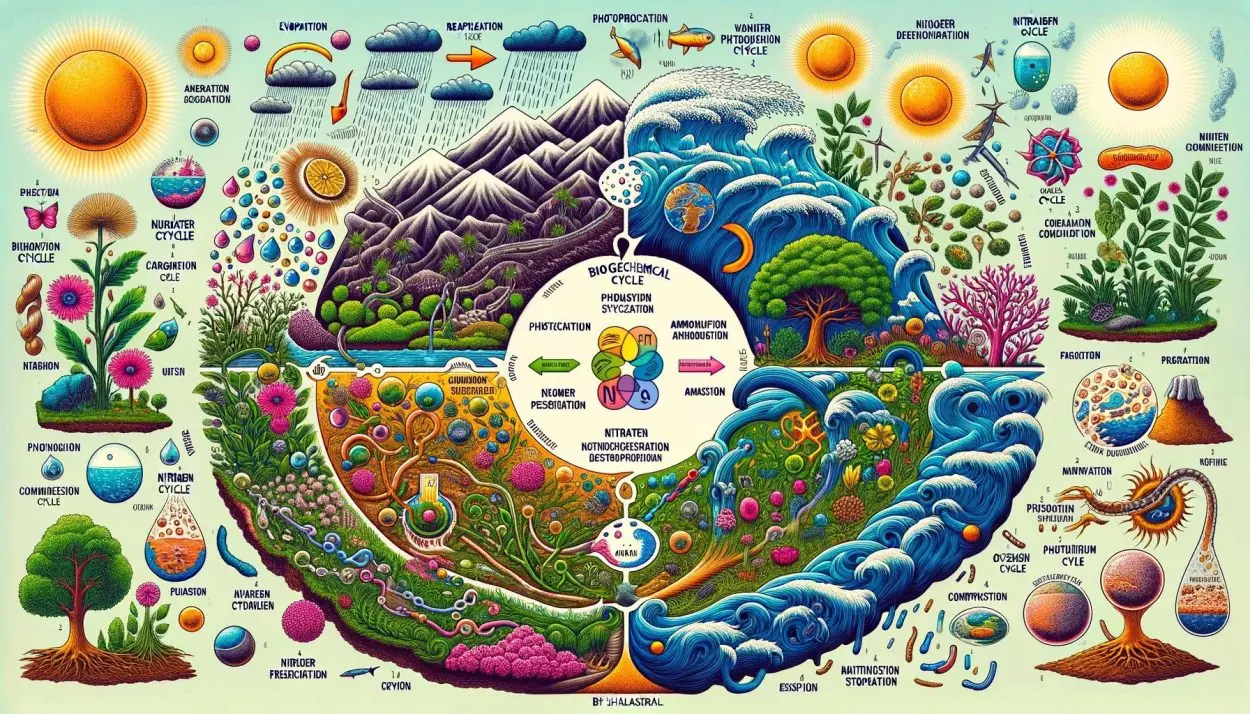
Each of these cycles plays a critical role in maintaining the balance of the earth’s ecosystems and supports various forms of life. Human activities, such as industrial processes, agriculture, and deforestation, are impacting these natural cycles, leading to environmental issues like climate change and eutrophication.
VI. Biodiversity
Biodiversity refers to the variety of life on Earth at all its levels, from genes to ecosystems, and the ecological and evolutionary processes that sustain it.
A. Importance of Biodiversity
- Ecosystem Stability: Biodiversity ensures the stability and sustainability of ecosystems. A diverse ecosystem is more resilient to changes and disturbances.
- Economic Value: Many economic activities depend on biodiversity, including agriculture, forestry, fisheries, and tourism.
- Medicinal Resources: A significant proportion of pharmaceuticals are derived from biological sources, highlighting the importance of preserving species diversity.
- Cultural and Aesthetic Value: Biodiversity enriches cultures and provides aesthetic value to human life.
- Ecological Services: These include air and water purification, soil fertility, pollination of crops, and carbon sequestration.
B. Levels of Biodiversity
- Genetic Diversity: Variability in the genetic makeup among individuals within a single species.
- Species Diversity: Variety of species within a habitat or a region.
- Ecosystem Diversity: Variety of ecosystems in a given place.
C. Threats to Biodiversity
- Habitat Loss and Fragmentation: Caused by activities like deforestation, urbanization, and agriculture.
- Pollution: Air, water, and soil pollution can severely affect biodiversity.
- Climate Change: Alters habitat conditions, affecting species survival.
- Overexploitation: Unsustainable fishing, hunting, and harvesting lead to species depletion.
- Invasive Species: Non-native species can outcompete native species for resources.
- Disease: Can spread rapidly and affect entire species.
D. Conservation of Biodiversity
- Protected Areas: Establishing national parks, wildlife reserves, and marine protected areas.
- Sustainable Practices: Promoting sustainable agriculture, fishing, and forestry.
- Legislation and Policies: Enforcing laws and regulations that protect species and habitats.
- Restoration Ecology: Restoring degraded ecosystems to their natural state.
- Education and Awareness: Increasing public understanding and support for biodiversity conservation.
- International Cooperation: Biodiversity conservation efforts often require global collaboration.
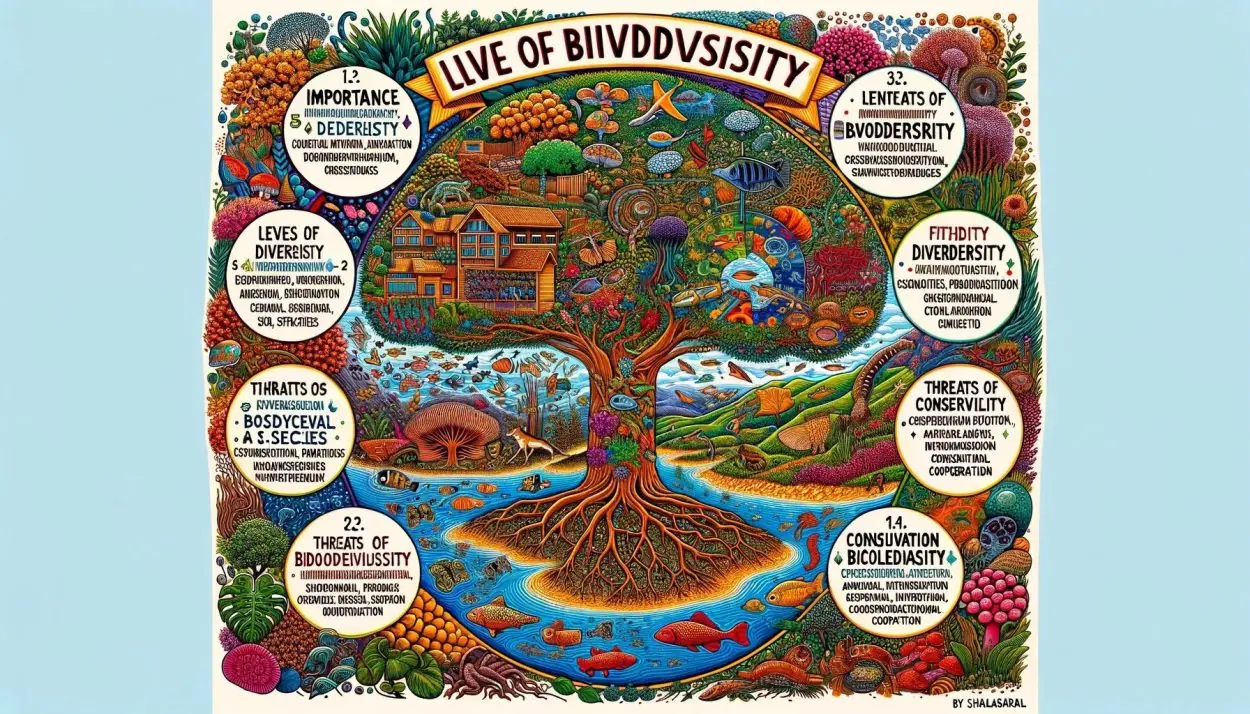
Biodiversity conservation is essential for the health of the planet and the well-being of all its inhabitants. It requires a multifaceted approach involving science, policy, and community participation.
VII. Human Impacts on Ecosystems
Human activities have significant impacts on ecosystems. These impacts range from altering natural landscapes to contributing to climate change. Understanding these effects is crucial for developing effective conservation and sustainability strategies.
A. Pollution and Its Effects
- Air Pollution: Emissions from industries and vehicles release greenhouse gases and pollutants, leading to smog, acid rain, and respiratory problems in animals and humans.
- Water Pollution: Discharge of industrial and agricultural chemicals, oil spills, and plastic waste affects aquatic life and contaminates water sources.
- Soil Pollution: Use of pesticides and disposal of industrial waste degrade soil quality, affecting plant growth and food safety.
B. Deforestation and Habitat Destruction
- Loss of Biodiversity: Clearing forests for agriculture or urban development destroys habitats, leading to species extinction.
- Soil Erosion and Degradation: Trees help in maintaining soil fertility. Without them, soil erosion and degradation occur.
- Climate Impact: Trees absorb CO2. Deforestation contributes to increased atmospheric CO2 levels, exacerbating climate change.
C. Climate Change and Global Warming
- Rising Temperatures: Emissions of greenhouse gases from human activities trap heat in the atmosphere, causing global temperatures to rise.
- Melting Ice Caps and Rising Sea Levels: Higher temperatures lead to the melting of polar ice caps and glaciers, increasing sea levels.
- Extreme Weather Events: Climate change is linked to increased frequency and severity of extreme weather events like hurricanes, droughts, and heatwaves.
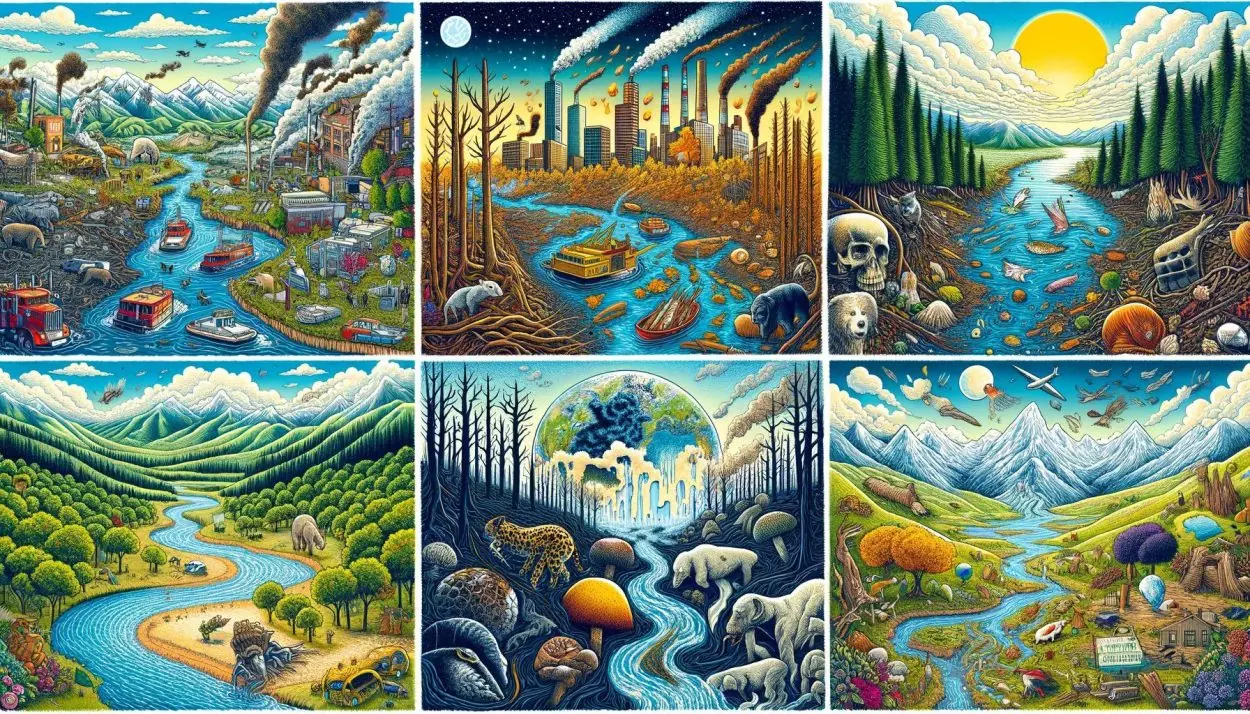
D. Conservation Efforts and Sustainable Practices
- Protected Areas: Establishing national parks, wildlife reserves, and marine sanctuaries to protect natural habitats.
- Sustainable Resource Use: Implementing practices in agriculture, fishing, and forestry that don’t deplete resources.
- Renewable Energy: Transitioning to renewable energy sources like solar, wind, and hydroelectric to reduce reliance on fossil fuels.
- Waste Management: Reducing, reusing, and recycling to minimize waste.
- Environmental Legislation: Enforcing laws to protect endangered species, regulate emissions, and manage natural resources sustainably.
Human impacts on ecosystems are profound, but with informed conservation efforts and sustainable practices, it is possible to mitigate these effects and preserve the planet’s ecological balance.
VIII. Sustainable Development and Ecosystems
Sustainable development involves meeting the needs of the present without compromising the ability of future generations to meet their own needs. It focuses on balancing economic growth, environmental protection, and social equity
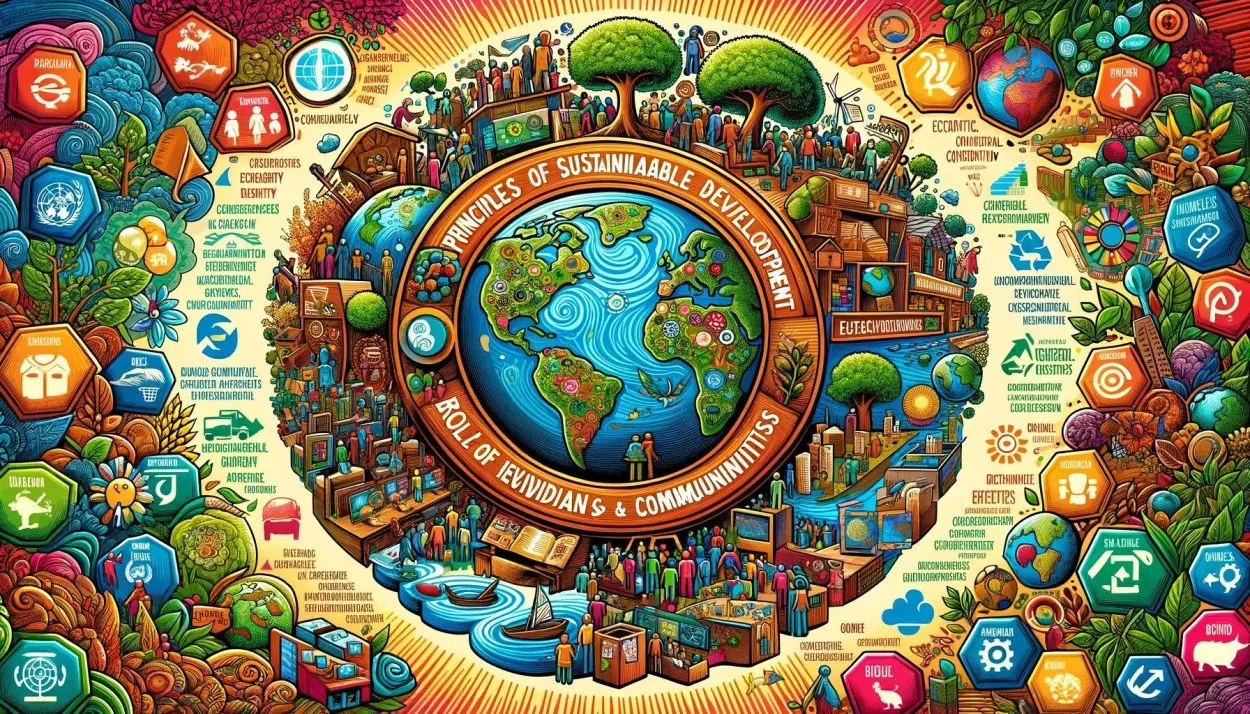
A. Principles of Sustainable Development
- Interdependence: Recognizing that economic, social, and environmental systems are interconnected and that policies and actions must consider all three aspects.
- Equity and Justice: Ensuring equitable access to resources and opportunities for all, including future generations, and addressing issues of social and environmental justice.
- Precautionary Principle: Acting cautiously when an action might cause severe or irreversible harm to the public or the environment, even if the full extent of the risk is not known.
- Conservation of Nature: Protecting, restoring, and using natural resources wisely to maintain ecosystem health and resilience.
- Sustainable Consumption and Production: Using resources efficiently, reducing waste and pollution, and promoting products and technologies that are sustainable.
- Public Participation: Involving citizens in decision-making processes to ensure that development is socially inclusive and accountable.
B. Role of Individuals and Communities
- Lifestyle Choices: Making personal choices that reduce environmental impact, such as using renewable energy, recycling, and choosing sustainable products.
- Community Involvement: Participating in local sustainability initiatives, community planning, and conservation efforts.
- Education and Advocacy: Spreading awareness about sustainability issues and advocating for policies that support sustainable development.
C. Global Initiatives and Agreements
- United Nations Sustainable Development Goals (SDGs): A set of 17 goals adopted by UN member states in 2015, aiming to end poverty, protect the planet, and ensure prosperity for all by 2030.
- Paris Agreement: An international treaty on climate change, aiming to limit global warming to well below 2 degrees Celsius compared to pre-industrial levels.
- Convention on Biological Diversity (CBD): An international agreement aimed at conserving biological diversity, using biological resources sustainably, and sharing the benefits of genetic resources fairly and equitably.
IX. Conclusion
Understanding our environment and ecosystems is vital for numerous reasons:
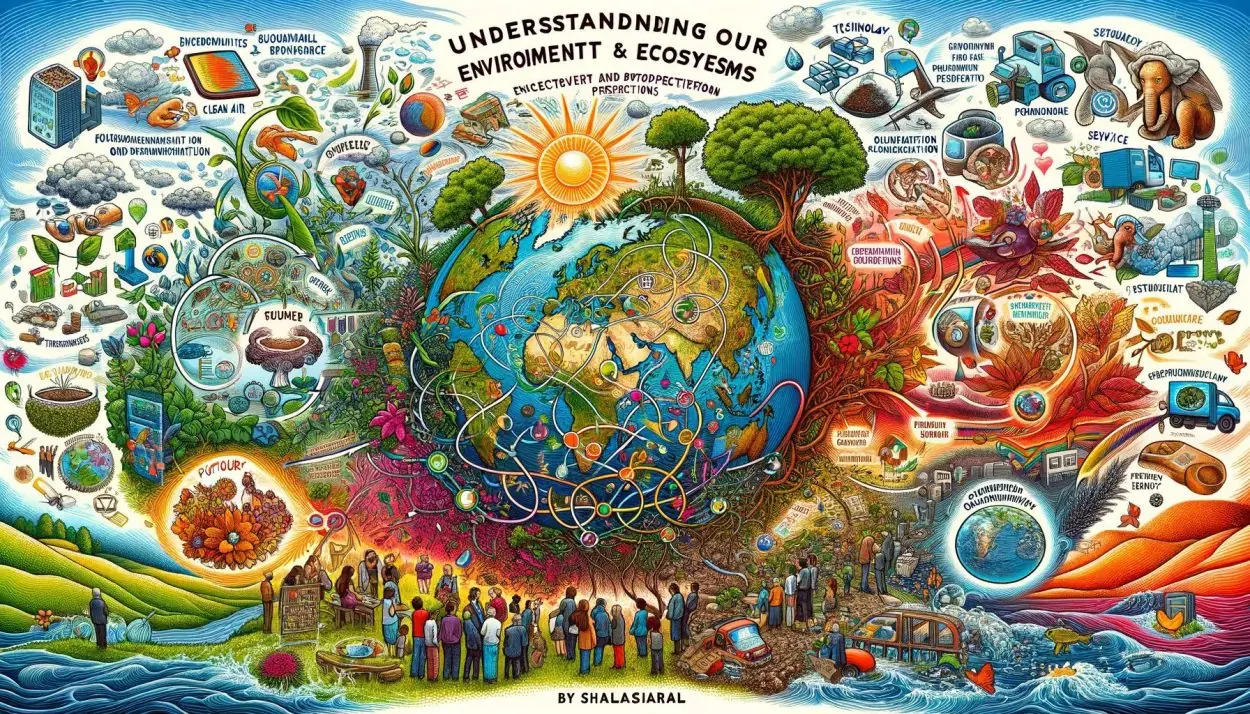
- Interconnectedness: Recognizing the interdependence between humans and the environment is crucial for sustainable living. Every action we take has a ripple effect on the natural world.
- Ecosystem Services: Ecosystems provide essential services like clean air and water, fertile soil for agriculture, and resources for shelter and medicine. Preserving these services is integral to human survival and well-being.
- Biodiversity Conservation: Biodiversity is essential for ecosystem resilience and adaptability. Protecting diverse species ensures a balanced and functional ecosystem.
- Climate Stability: Ecosystems play a significant role in regulating the Earth’s climate. Forests, oceans, and wetlands, for instance, are critical in sequestering carbon dioxide, a key greenhouse gas.
Future Perspectives and the Need for Continued Conservation Efforts:
- Sustainable Development: Future strategies must focus on sustainable development that balances environmental, social, and economic needs, ensuring a livable planet for future generations.
- Technology and Innovation: Leveraging technology for environmental monitoring, renewable energy, and sustainable practices can significantly reduce human ecological footprints.
- Global Collaboration: Environmental challenges like climate change and biodiversity loss are global issues that require international cooperation and unified action.
- Education and Awareness: Increasing public awareness and education about environmental issues is vital for fostering a culture of conservation and responsible stewardship.
- Policy and Regulation: Strong environmental policies and regulations are essential to protect natural resources and ensure compliance with sustainable practices.
In conclusion, our future well-being is deeply connected to the health of our environment and ecosystems. Continued efforts in conservation, innovation, education, and policy are essential to safeguard the planet for both current and future generations.